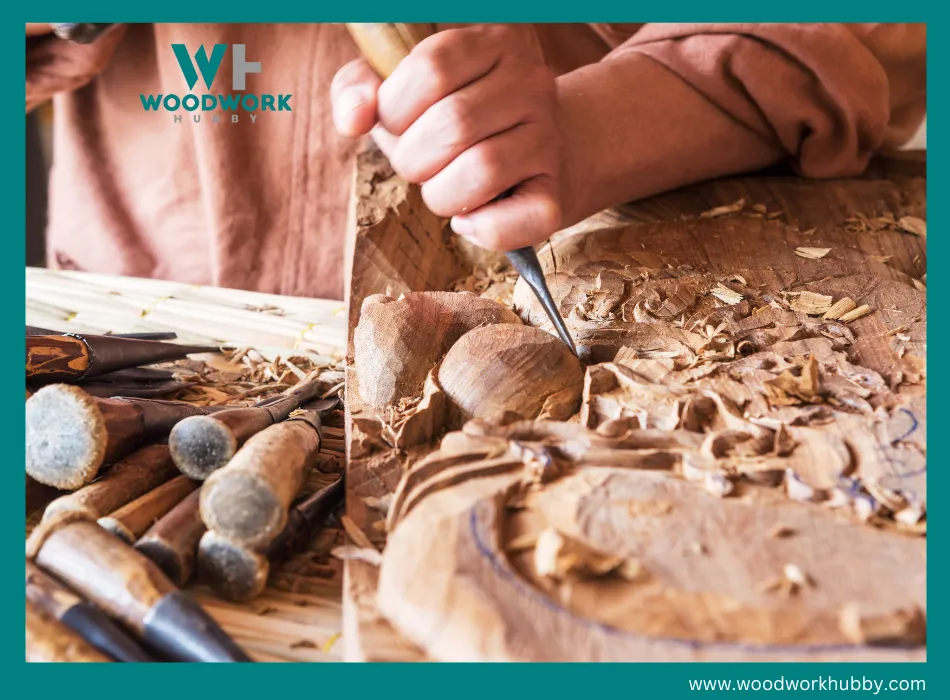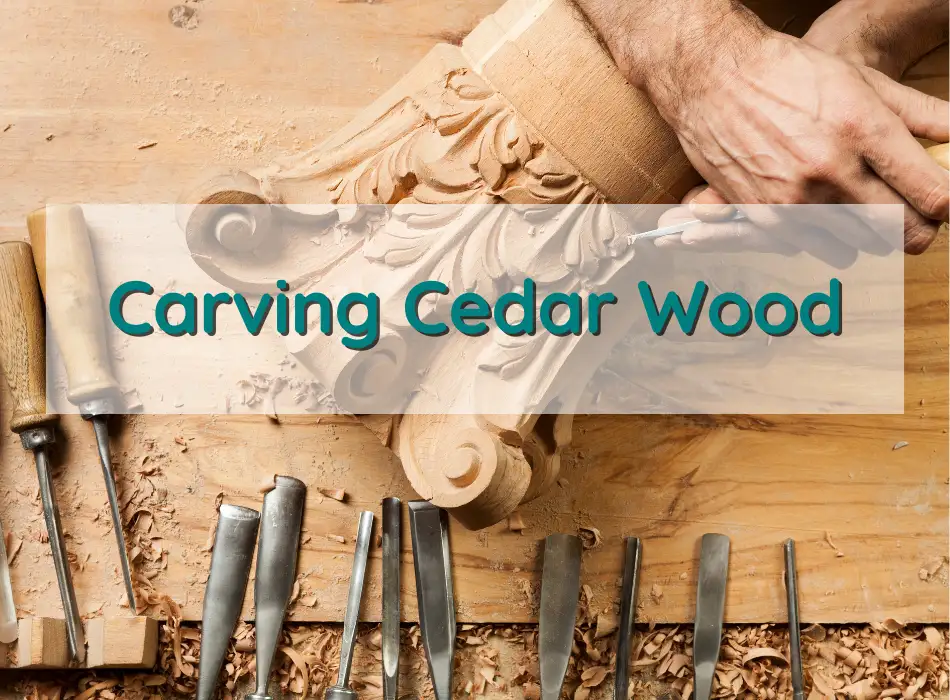I picked up wood carving again recently and ran out of the only basswood block I had lying around. The closest thing in hardness that I had was cedar, and I was quite surprised by the results of my first attempt at carving cedar. With around a week of carving cedar and over two decades of carving experience in general, I’ve come to a conclusion.
Carving cedar wood is possible, but only if the level of detail required in the project isn’t too intricate. Cedar can be cut with ease using hand carving as well as power carving tools. But overall, cedar carvings are best when they are medium-scale outdoor projects.
In this article, you will learn more about cedar wood carving, including which kinds of projects you can carve out of cedar, the types of cedar that are easiest to carve, and what you must keep in mind when carving cedar. So let’s get started!
The Factors That Affect Carving Potential And Results
Before we get into the specifics of carving cedar, we have to address the aspects of wood that determine its carvability and the quality of the carving. Here are the things to keep in mind when carving cedar wood.
Ideally, wood must be soft and durable to be carved with ease and last long. But if the carving needs to have fine details, then it must also be close–grained. Cedar has two out of these three factors, which is why it is a pretty good wood for carvers.

Can I Carve Cedar Wood?
You can carve cedar wood because it is a softwood with a Janka hardness of 350 to 500 lbs on the low end. Some types of cedar are harder and are not good for hand carving. But general-use cedar checks off most of the boxes of carving-friendly wood.
- Hardness – Atlantic white cedar and yellow cedar have a Janka hardness of 350 to 500 lbs. This is in the ballpark of basswood 410 lbs, which is considered a beginner-friendly carving wood.
- Grain – Cedar isn’t as good as basswood in its grain type, though. It has an open-grain pattern which makes it impossible for the wood to have fine details carved on it. The crevasses of the open grain pattern act as carved lines already. In contrast, basswood’s a closed grain, like a plain surface upon which even the finest details can be etched.
- Durability – Cedar is rot-resistant and repels insects. This makes large cedar carvings incredibly resilient.
How Well Does Cedar Carve?
You can carve cedar with around the same effort as carving a standard softwood. However, you’ll have a tough time registering and maintaining details finer than 0.5 inches on the wood because of its open grain pattern.
Cedar is good for medium-scale sculptural work because it can withstand the elements and exterior exposure. It is also easier to carve broad details into cedar because of its straight grain and overall softness.
Is Cedar Wood Easy To Carve?
Cedar wood is easy to carve, but it is not the easiest carving wood. Its straight grain and softness make the process of cutting into this wood fairly simple.
Carvings that rely on slopes and geometric cuts can be made very easily with cedar. But when you start trying to make finer carvings with more intricate details, you run into the limitations of cedar.
Pros and cons of carving cedar wood?
All wood types have their own limitations in different contexts, including carving. Cedar also has pros and cons when it comes to carving. Understanding the advantages and disadvantages of choosing cedar for your carving will help you manage expectations and avoid disappointment.
The Advantages Of Carving Cedar Wood Are As Follows:
The Cons Of Using Cedar For Carving Are As Follows:
Overall the advantages of cedar make it great for medium-scale carvings that function as outdoor decor. Still, its rot-resistance and ability to withstand water exposure might tempt you to carve smaller projects like spoons out of it.
Is Cedar Good For Making Spoons?
Cedar isn’t good for making long-lasting spoons because the porous surface of cedar is antithetical to the function of a spoon. A spoon must not trap food residue to be functional, while a cedar surface is likely to trap food particles.
If you coat cedar spoons with a food-safe resin, then it is possible to use them like regular spoons. This is an expensive workaround compared to using basswood for spoons. The natural rot-resistance of cedar, then, isn’t of as much value in food utensils and kitchen carvings. It is much better for outdoor carvings.
See my article on the best wood for spoon carving.
Is Cedar Wood Good For Chainsaw Carving?
When it comes to outdoor carvings, one of the most awe-inspiring carving types is chainsaw carving. While cedar’s exterior-friendliness makes it seem like it would be great for a chainsaw carving, its Janka hardness can confuse a new woodworker.
Cedar wood is good for chainsaw carving as long as the carver sharpens the saw blade and cuts along the wood grain. Otherwise, cedar wood might split and chip instead of getting carved as intended. Chainsaw carvings rely on broad details, which cedar is actually good for.
Where cedar fails is in the intricate details aspect. And that limits the types of carvings that cedar can be used for. Among these carving, types are whittling, which is an act of carving by hand.
Is Cedar Good For Whittling?
Cedar is easy to whittle but hard to whittle accurately. You’ll find the whittling knife moving through it much faster than it would move through a harder wood type. As a result, you’d need to exercise better control, which ultimately makes you a better carver.
That said, you cannot use cedar for all types of whittling projects. The more intricate the carving requirements, the more problematic it is to use cedar for a specific carving project.
Cedarwood Carving Projects
The best carving projects for cedar wood are ones that require geometric cuts and fewer details. It is even better when said projects need to be placed outdoors because that’s where cedar gives the most value.
A Cedar Owl
One of the few cedar carving projects that do not involve power carving is the Cedar owl. You can use a whittling knife and hand-carving tools to craft an owl. Because of their thicker feather structure and wide eyes, owls don’t need excessive carving intricacy, which is why they can be made from cedar.
A Red Cedar Gnome
Wood gnomes are popular carving projects, but they don’t last as long when made from wood that can be carved by hand. You can use harder red cedar and power tools to shape a more permanent version of a wood gnome.
Cedar Bowl
A cedar bowl for exterior decoration can be made with the help of a few power tools. You can manually hollow out the wood, but that takes time. Usually, hand carving has the advantage of offering detail, but details aren’t as important in the project, so you can prioritize speed.
Pine Tree Decoration With Cedar
Using a chainsaw, one can carve a pine tree out of a cedar stump. This is a great Christmas decoration idea for those who have a cedar stump in their garden or backyard.
You can even buy a cedar log and plant it into the ground just to make this decoration. Cedar’s natural rot resistance keeps the wood from deteriorating even if it is planted in the soil.
Is Red Cedar Good For Carving?
Red Cedar is good for carving with power tools and too tough to carve accurately with hand tools. Still, you can cut red cedar without power tools, so it is technically possible to carve it with a carving knife.
Red cedar is best for carving outdoor projects that are meant to last a long time. For intricate details, power tools with precise rotary aspects should be used, while broader aspects should be carved with flat blades.
Is White Cedar Wood Good For Carving?
White cedar is good for hand carving as it is much softer than red cedar. It is best for carving wood signs, which have just the right level of detail for open-grained wood.
Best Cedar Alternatives For Carving
By now, you can see that cedar has utility in outdoor carvings and medium-scale projects. That means that indoor carvings of small scale are better left to other wood types. The best alternatives for carving cedar would have closed straight grain and a similar Janka hardness.
- Basswood – Closest to white cedar in Janka hardness and grain-straightness. Its advantage over cedar is its closed grain.
- Aspen – It generally has a straight fine grain with a Janka hardness close enough to white and yellow cedar.
- Black walnut – With a Janka hardness closer to red cedar, black walnut is a straight and tight-grained wood that is a favorite among carvers.
Final Thoughts – Carving Cedar Wood
White cedar is good for medium-scale carving but is a poor choice for projects that require intricate details to be carved across a flat surface. While cedar is soft enough to be hand-carved, it doesn’t have a flat vertical surface, as its open grain forms small peaks and valleys. Still, it can be used to carve projects as long as they don’t need fine etching.
Exterior decor rarely needs to be too detailed as it is observed from afar anyway. Cedar’s softness, alongside its natural rot resistance, makes it very useful for a very specific category of carvings. For most other carving types, better lumber exists.




